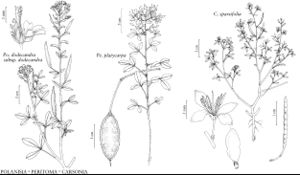Peritoma
in A. P. de Candolle and A. L. P. P. de Candolle, Prodr. 1: 2371824.
| Taxon | Illustrator ⠉ | |
|---|---|---|
 | Polanisia dodecandra Polanisia dodecandra subsp. dodecandra Peritoma platycarpa Carsonia sparsifolia | Yevonn Wilson-Ramsey Yevonn Wilson-Ramsey Yevonn Wilson-Ramsey Yevonn Wilson-Ramsey |
Herbs or shrubs, annual or (weak) perennial. Stems sparsely or profusely branched; glabrous, or glabrate, or glandular-pubescent. Leaves: stipules scalelike, bristlelike, or absent; petiole with pulvinus basally or distally; leaflets 3 or 5, (conduplicate and flat). Inflorescences terminal or axillary (from distal leaves), racemes (flat-topped or elongated); bracts usually present. Flowers zygomorphic; sepals persistent or deciduous, distinct or partly connate (1/3–1/2 of lengths), equal (each often subtending a nectary); petals equal; stamens 6; filaments inserted on cylindric androgynophore (usually expanded adaxially into a gibbous or flattened appendage), glabrous; anthers (linear), coiling as pollen released; gynophore usually recurved in fruit (sometimes reflexed). Fruits capsules (erect to pendent), dehiscent, usually oblong (obovoid, subglobose, or fusiform in P. arborea). Seeds 5–38, globose, obovoid, triangular, or horseshoe-shaped, not arillate, (cleft fused between ends). x = 10.
Distribution
North America, Mexico
Discussion
Species 6 (6 in the flora).
Whether included in Cleome or treated as a separate genus, Peritoma comprises mostly distinct, western North American species, perhaps related to African genera. It is best treated as a taxon equivalent in rank to its three derivative genera, Cleomella, Oxystylis, and Wislizenia (2n = 40). These can be arranged in a much studied fruit and seed reduction series correlated with increasing aridity (H. H. Iltis 1955, 1956, 1957; K. Bremer and H. Wanntorp 1978; S. Keller 1979; S. S. Vanderpool et al. 1991). Some botanists may object to inclusion of the well-established Isomeris arborea in Peritoma. It is the only long-lived woody shrub species in the North American Cleomaceae. Except for the larger size, the flowers are basically identical (as are the fruits and seeds) to those of species such as P. lutea, a fact appreciated long ago by E. L. Greene when that notorious splitter lumped Isomeris with its relatives in Cleome.
With six sharply distinct species (H. H. Iltis 1957), Peritoma is an exceptionally robust and relatively ancient genus, usually characterized by the rather thick trifoliolate and glabrous leaves, yellow (except a rich purple in P. multicaulis and P. serrulata) petals, and, usually, well-developed nectary discs.
Selected References
None.
Lower Taxa
Key
| 1 | Shrubs; capsules usually inflated, 6-12 mm diam. | Peritoma arborea |
| 1 | Annuals; capsules not inflated, 1.5-12 mm diam | > 2 |
| 2 | Leaflets 5 (proximally) | > 3 |
| 2 | Leaflets 3 (throughout) | > 4 |
| 3 | Capsules 15-40 mm; gynophore 5-17 mm in fruit; petals light yellow, 5-8 mm; stamens 10-15 mm; plants (15-)25-30 cm. | Peritoma lutea |
| 3 | Capsules 40-60 mm; gynophore 15-25 mm in fruit; petals golden yellow, 10-13 mm; stamens 20-30 mm; plants 50-100(-200) cm. | Peritoma jonesii |
| 4 | Petals golden yellow; capsules pendent, glandular-pubescent. | Peritoma platycarpa |
| 4 | Petals purple, pink, rose, or white; capsules erect or reflexed, glabrous | > 5 |
| 5 | Leaflets 0.6-1.5 cm wide; petioles 1.5-3.5 cm; petals 7-12 mm; capsules 23-76 mm. | Peritoma serrulata |
| 5 | Leaflets 0.1 cm wide; petioles 0.5-1.5 cm; petals 4-5 mm; capsules 15-25 mm. | Peritoma multicaulis |